Salvador Dali Museum Florida Art Contest in the 90s
Introduction
The "Marvels of Illusion" exhibit, shown at The Dali Museum in Leningrad, FL., from June 14 to October 12, 2014, offered visitors a unique perceptual and cognitive experience into the globe of ambiguity and illusions. The exhibition displayed a number of paintings, prints and sculptures by Salvador Dali (1904-1989), a sixteenth century piece from the School of Arcimboldo that was on loan from the Ringling Museum, and interactive demonstrations and illustrative material. Here we review the role of illusions in the art of Dali, focusing on the pieces displayed at the "Marvels of Illusion" exhibit.
Illusions are noted equally the disconnect between physical reality and subjective perception (Martinez-Conde and Macknik, 2010). When experiencing a visual illusion, we may see something that is non there in reality, fail to see something that is, or more generally see something different from what is at that place. Due to this disconnect between perception and reality, visual illusions exemplify how the brain fails to re-create the physical world, and provide vision scientists with substantial tools to apply to the report of the neural underpinnings of perception.
Throughout history, artists and researchers have utilized illusions with the aim of understanding perception. Many years earlier scientists began studying neuronal properties, artists devised multiple techniques to trick the brain into believing that a apartment canvas had depth or that a sequences of brushstrokes was in fact a notwithstanding life. Factors such every bit effulgence, color, shading, and middle movements, among other contributors, can powerfully affect what we encounter.
Salvador Dali intuited that what we construe visually equally reality is the product of the habits of the listen, more than of the middle. He understood that we create an ordered or disordered world from intermittent and incomplete retinal data candy past our mind's experiences, desires and apprehensions. Thus, Dali'south artworks challenge the viewers' perceptions of reality and enable them to run across beyond the surface. Visual illusions, nowadays in many of the painter'south artworks, include numerous examples of perceptual completion and ambiguous images.
Illusory Contours and Filling-in Illusions in Dali'south Art
Our brain makes up a large fraction of what we perceive. High-resolution vision is limited to the center of our eyes—virtually a tenth of a percent of the entirety of our visual field—, simply we perceive the whole visual field equally a loftier-resolution, focused, perfectly formed paradigm. This is a grand illusion that results from the articulation action of the neural systems responsible for our vision and eye movements.
Various perceptual rules, such equally the Gestalt laws conceptualized in the tardily 19th and early 20th centuries, govern the way our brains fill up in incomplete information. For instance, the Gestalt Principle of Closure says that our perception will group individual elements as a whole (rather than consider them as separate from each other) if they seem to consummate an entity. The Kanizsa triangle illusion appears every bit a ghostly triangle partially superimposed on three circles at the triangle's vertices. We perceive the triangle, rather but than the three Pac-men that are actually present, because our brain overlays the shape of a triangle on an extremely limited field of information. The illusory triangle manages to look slightly whiter than the background, though information technology is in reality the same shade. A slap-up deal of our everyday experience consists of similar feats of filling in perceptual and cognitive gaps, where we use what we know about the world to imagine what we do not know.
Our visual arrangement is ingrained with the ability to detect and process faces rapidly and with efficiency, even with few details. Fifty-fifty infants look at bones depictions of faces for longer times than they explore similar cartoonish faces in which the eyes and other features are scrambled. The neurons responsible for our refined "face sense" lie in the fusiform gyrus or fusiform face surface area, a brain region that becomes active not but when we detect an bodily confront, but also when nosotros perceive an illusory or imaginary face. Meng et al. recently establish that, whereas both faces and objects that look like faces activate the left fusiform gyrus, real faces activate the right fusiform gyrus much more strongly than look-alikes (Meng et al., 2012).
Trauma or lesions to the fusiform face expanse result in a prosopagnosia, or face blindness. But even people with standard face-recognition skills are susceptible to various face perception illusions. Many of these occur when the visual system fills in the gaps to create a consummate face from scarce visual content.
"Face pareidolia" refers to our visual organisation's predisposition to notice faces in adventitious or vague visual information. Common examples are finding faces on the fronts of cars and buildings. This phenomenon results from face-recognition circuits that are constantly at piece of work to discover a confront in the crowd. Our encephalon's bent to detect pregnant, united with an outstanding skill for face detection, can pb to spectacular cases of pareidolia. A grilled-cheese sandwich, with an image resembling Virgin Mary burned into the breadstuff, sold on eBay for $28,000 (Martinez-Conde and Macknik, 2012).
The brain's ability to fabricate links amid things that are in reality unconnected is essential to the "paranoiac-disquisitional method" artistic method invented by Dali. (In fact, paranoia and pareidolia share a mutual etymology, from the Greek para- for "instead of" and -oid, -oeides, or -eidos for "grade").
Paranoia—Oil on Canvas, 1935–36
Paranoia provides a striking case of an illusory contour resulting from filling-in processes. A battle scene reminiscent of some of Leonardo Da Vinci's sketches hovers over a bust set on a pedestal. The bust is headless, yet we perceive a head (Effigy 1).
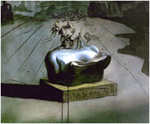
Figure one. Paranoia, by Salvador Dali, Oil on sheet, 1935–1936. ©Salvador Dali. Fundación Gala-Salvador Dali (Artist Rights Club), 2015. Collection of the Salvador Dali Museum, Inc., Saint petersburg, FL, 2015. Reproduced with kind permission from the Salvador Dali Museum, Inc.
The small figures that appear to be standing on or backside the woman's neck grade her mentum, mouth, and nose. In the distance, groups of men on horseback form the eyes and hairline. The encephalon so fills in the missing lines and contours of the woman's face (Cox et al., 2004). Facial recognition is a dominant perceptual function, so the encephalon easily completes the head despite having to fabricate most of the data.
The woman's face can be seen more easily by squinting our eyes to mistiness the distinct edges of the minor figures. Interestingly, there is also a double image in the confront. Some people can see a sweet woman with downcast eyes, while others see a wild-eyed woman with a sinister grin (come across "Cryptic Illusions" section for more examples of perceptual ambiguity in Dali's fine art).
Paranoia pays homage to Leonardo, non only in the delineation of the boxing scene, but as well in following his advice to find perceptual patterns in meaningless objects: "…stop sometimes and look into the stains of walls, or ashes, or a fire, or clouds, or mud, or like places, in which, if you consider them well, you may find actually marvelous ideas," Leonardo wrote in his notebooks.
The Madonna of the Birds—Watercolor on Newspaper, 1943
The Madonna of the Birds watercolor (Figure 2, left) is based on the Italian High Renaissance artist Raphael's (1483-1520) Alba Madonna, c. 1511 (Figure 2, right). In Dali's version, the torso is only suggested, and the face is formed past a flock of birds. Neurons in our visual cortex connect the shapes of the private birds, to course the illusory contour of the expected just missing head, too as the hair, eyes, oral fissure and mentum. Dali kept the hue and value of the birds subdued, to just hint at the confront.

Figure 2. Left: The Madonna of the Birds, past Salvador Dali, Watercolor on paper, 1943. ©Salvador Dali. Fundación Gala-Salvador Dali (Artist Rights Society), 2015. Drove of the Salvador Dali Museum, Inc., St. petersburg, FL, 2015. Reproduced with kind permission from the Salvador Dali Museum, Inc. Right: Alba Madonna, past Raphael, c. 1511.
Connecting the caput to the body requires a larger perceptual endeavor than filling in the face. The body gap is large, and the lack of details and suggestive lines in the bodice challenges our visual system to generate the perception of a whole upper trunk where nosotros know it should be.
Dali's borrows the compositional arrangement of Raphael'south original. In Dali'south version, the Christ child, identified by a halo, holds the slender cantankerous while seated on the Virgin'due south lap. Some other child, John the Baptist, reaches up to face the Madonna with a minor bird in hand. Dali replicates the sandal worn past Raphael'southward Madonna.
La Soif (Thirst)—Ink and Gouache on Paper, 1965
In Thirst, Dali either used decalcomania (folding a piece of paper with wet gouache inside, and so peeling it open) or took an ink-soaked cloth and pressed it onto the surface of the paper. Inside the ink and gouache blotches he visualized two Renaissance figures in catamenia clothing, 1 serving wine to the other (Figure 3). He then drew line and shape fragments and left it to our imagination to complete the implied presence of objects in the scene. The trousers of the person in the correct are little more than blotches of ink, and notwithstanding, in context, our perceptual processes fill in the missing information so we recognize the overall shape as a piece of clothing.

Figure 3. La Soif, by Salvador Dali, Ink and gouache on newspaper, 1965. ©Salvador Dali. Fundación Gala-Salvador Dali (Artist Rights Lodge), 2015. Collection of the Salvador Dali Museum, Inc., Saint petersburg, FL, 2015. Reproduced with kind permission from the Salvador Dali Museum, Inc.
Dali created his own system of observation, his celebrated paranoic-critical method, in which the artist could expect at whatsoever object and run across another. In The Conquest of the Irrational, Dali described that his aim was to "materialize the images of concrete irrationality with the most imperialist fury of precision" (Dali, 1935). Dali's goal was to accomplish images that could not be analyzed or macerated by rational logic.
Dali was very familiar with Leonardo da Vinci's notes in his Treatise on Painting, which contained the following advice on seeing hidden images: "await at certain walls dirtied with various stains…y'all will exist able to see various battles and figures…and strange expressions on faces, and costumes, and an infinite number of things" (Da Vinci, 1956). Dali's ability to identify unlike images within a given configuration allowed him to perceive reality from a fresh perspective.
Cryptic Illusions in Dali'southward Art
Dali's fine art includes frequent examples of ambiguous illusions, where the brain interprets the same picture in two mutually exclusive ways. The physical object is unchanged, yet information technology produces 2 (or more) contradictory percepts. By creating accessible double images, Dali asks u.s. to reconsider on a fundamental calibration our constructs of reality.
Femme-Cheval—Ink, 1933
Dali'south Femme-Cheval challenges the viewer to decide if the two fatigued figures are function of one image or another, and to guess where ane figure ends and the other begins. The intermingling of the mane and the woman's hair, or the woman'south legs that are rendered so faintly that they disappear, causes perceptual ambivalence (Figure 4). Our brain likewise fills in incomplete or missing information for each of the perceptual interpretations. Many of the illusions that we discuss hither as ambiguous likewise include significant illusory contours and filling-in/perceptual completion, and vice versa. The various illusory components play off, and enhance, each other.
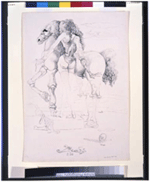
Figure iv. Femme-Cheval, by Salvador Dali, Ink, 1933. ©Salvador Dali. Fundación Gala-Salvador Dali (Artist Rights Club), 2015. Collection of the Salvador Dali Museum, Inc., Saint petersburg, FL, 2015. Reproduced with kind permission from the Salvador Dali Museum, Inc.
According to Dali's 1930 essay L'Ane pourri, "The double image (an example of which might exist the epitome of a horse that is at the same time is the epitome of a woman) may be extended, continuing the paranoiac procedure, with the existence of another obsessive thought existence sufficient for the emergence of a third image […] and thus in succession until [the number of images is] express only by the extent of the mind's degree of paranoiac capacity (Dali, 1998a)."
Nieuw Amsterdam—Bronze Sculpture Painted with Oil and Added Metal, 1974
Dali painted straight onto a copy of the famous nineteenth-century bronze bust of White Hawkeye (1899) past the American sculptor, Charles Schreyvogel (1861–1912). In doing so, Dali transforms the bust into a 3-dimensional scene as envisioned by his paranoic-critical method (Figure five). Although technically this may be classified every bit an ambiguous illusion, the ambiguity between competing perceptions (scene vs. face up) is more subtle than in other artworks. The ambiguity arises when Dali uses the facial features of the sculpture to define a scene: the outline of White Eagle's eyes course the faces, the cheekbone shadowing forms the arms, the chin forms the table.
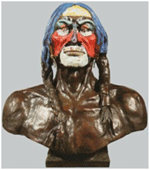
Figure 5. Nieuw Amsterdam, by Salvador Dali, Bronze sculpture painted with oil & added metal, 1974. ©Salvador Dali. Fundación Gala-Salvador Dali (Artist Rights Guild), 2015. Collection of the Salvador Dali Museum, Inc., Saint petersburg, FL, 2015. Reproduced with kind permission from the Salvador Dali Museum, Inc.
The painted scene features two Dutch merchants at a tabular array. On White Eagle'south forehead is a wall map surrounded by blue drapery. The scarlet capes of the merchants cover the cheeks while their plumed hats define the eyebrows. The merchants are seated on a divided miniature metal chair, which is attached to the bust. The figures are toasting a Coca-Cola canteen, the presence of which combines a modern symbol with the otherwise traditional embellishment of the sculpture. The primary'due south chin is transformed into a table elevation with the lips condign a handbasket of fruit.
Quondam Age, Adolescence, Infancy (The Three Ages)—Oil on Canvas, 1940
In The Three Ages, cues of textures and apparent openings propose a plausible wall of arches through which nosotros run across distant scenes. Competing with that interpretation, our visual arrangement's bias for face detection, and the high-contrast edges that define the shapes of the heads, indicate to our encephalon that we are seeing faces against a dark groundwork (Figure 6, left).

Figure vi. Left: Old Age, Adolescence, Infancy (The Three Ages), by Salvador Dali, Oil on sheet, 1940. Right: The Three Ages, with Adolescence subdued. ©Salvador Dali. Fundación Gala-Salvador Dali (Artist Rights Gild), 2015. Drove of the Salvador Dali Museum, Inc., St. Petersburg, FL, 2015. Reproduced with kind permission from the Salvador Dali Museum, Inc.
Dali'south selection of lighter hues and shading values for the three "faces" leads our perception to brand sense of the scene by grouping these areas equally facial entities, separate from the dark of the surrounding "background." Merely Dali may not have achieved equally much perceptual ambiguity as he sought. For Erstwhile Age and Adolescence, the faces dominate the ambiguity struggle, partially due to Dali'south choice of most saturated (solid) dark hues with high dissimilarity edges for the details of the faces, which sets up a strong preference in our brain for the facial interpretation. It is easier to encounter the Old Age and Adolescence faces (left and middle) than the arches and the scenes in the distance. Conversely, Infancy (right) blends more subtly with the opposing prototype of fisherwomen mending nets, resulting in greater ambiguity.
Dramatically subduing the figures and hills in Boyhood sets up a stronger ambiguity betwixt figure and groundwork where our listen now tin perceive an opening in the wall with greater ease than in the non-subdued image (Figure vi, right).
Study for "The Three Ages"—Pencil on Paper, 1940
As Dali prepared for The Three Ages, he sketched figures and experimented with shading, size, and other elements that would be in the final image (Figure 7). Seeing through the eyes of his paranoic-critical view of the world he searched for the elements that would best induce perceptual ambiguity.

Effigy 7. Study for "The Iii Ages," by Salvador Dali, Pencil on newspaper, 1940. ©Salvador Dali. Fundación Gala-Salvador Dali (Artist Rights Society), 2015. Collection of the Salvador Dali Museum, Inc., St. Petersburg, FL, 2015. Reproduced with kind permission from the Salvador Dali Museum, Inc.
Written report for "Disappearing Image"—Charcoal on Newspaper, 1939
Dali's preliminary study for The Three Ages explores the development of an ambiguous illusion. On the one hand, nosotros can easily meet through the archways, past the figures to the courtyard across. Simply we can also identify objects that look like optics, mouths, and heads that are strong triggers for our face detection neurons (Figure 8, left). The defoliation stretches our mind'south ability to make sense of what we are really seeing.

Figure eight. Left: Study for "Disappearing Epitome," past Salvador Dali, Charcoal on paper, 1939. Center: Study for Disappearing Images: enlarged face. Right: Study modified. ©Salvador Dali. Fundación Gala-Salvador Dali (Artist Rights Society), 2015. Collection of the Salvador Dali Museum, Inc., St. Petersburg, FL, 2015. Reproduced with kind permission from the Salvador Dali Museum, Inc.
While this study has an overall similarity to the last oil painting, the specific faces are different. In the oil painting, in that location is an allegorical progression of the three stages of man: infancy, boyhood, and old historic period (from right to left). In this earlier study, the specific faces are much less precise, and the lodge of the ages is reversed. An indeterminate face appears on the left, peradventure a child close to adolescence, and an older looking adolescent bearing a mustache is in the center. The face on the right is a skull, perhaps representing expiry, which Dali abandoned in the finished canvas.
Squinting or stepping away from the prototype blurs the fine details defining the objects and people inside the arches, allowing the face interpretation to dominate our perception instead.
Dali experimented very carefully with sketching shapes, shading, edge details, and placement to fix the double images. We can run into how these elements thing by zooming in on the middle image to eliminate the presence of a wall. The result is more than obviously a face (Effigy 8, center).
Conversely, softening the intensity of the features in the middle confront degrades the cues for face up detection and allows us to more easily perceive the curvation as a structure (Figure 8, right).
Changes in Peachy Masterpieces, Rembrandt—Lithograph, 1974
Dali paid tribute to the old masters, such as Raphael, Rembrandt, Ingres, Vermeer, and Velazquez, through his paranoiac-critical view of the earth. In Changes in Great Masterpieces, Rembrandt (1974), Dali saw an open door and receding dark hallway in the self-portrait of Rembrandt van Rijn (1606–1669), and set up a double image by using dissimilarity and shape cues (Effigy ix).
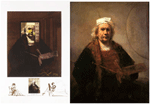
Effigy 9. Left: Changes in Groovy Masterpieces, Rembrandt, by Salvador Dali, Lithograph, 1974. ©Salvador Dali. Fundación Gala-Salvador Dali (Artist Rights Lodge), 2015. Collection of the Salvador Dali Museum, Inc., St. Petersburg, FL, 2015. Reproduced with kind permission from the Salvador Dali Museum, Inc. Correct: Rembrandt's original: Dali saw a receding dark hallway to a adult female in a lit room through an open up door.
To create perceptual ambivalence, Dali reduced the overall value of Rembrandt's prototype to create a much darker version of the portrait. This allowed him to transform the otherwise flat background into a receding wall meeting the floor at what would be Rembrandt'south arm. These cues of perspective produce the perception that the hallway recedes into the distance. The brighter opening suggests a lit room across the wall. An open door and the hard edges of a doorframe consummate that interpretation.
The ambiguity lies in how our perception switches back and forth between Rembrandt'south face up and the hallway scene. Equally is frequently the case in this type of illusion, focusing on the shut-up details helps the perception of one image (adult female in room at end of hall), while stepping back to view the whole reveals the larger portrait. Squinting 1's eyes likewise helps to perceive the portrait as the dominant scene, past blurring the edges and boundaries of the fine details of the door and hallway.
Transformation of Antiques Magazine Cover into the Bogeyman of Face—Gouache on Mag Encompass, 1974
Dali had a vision of a confront on the original cover of Antiques Magazine. He had been fascinated with camouflage and mimicry in nature since he was a child (see also "Tres Picos" for Dali'southward particular interpretation of camouflage in the natural globe). This fascination influenced the invisible and paranoic images that inhabit his paintings.
In the Transformation of Antiques Mag Cover…, Dali creates an ambiguous illusion where our visual organisation struggles between the alternate and incompatible perceptions of a face and a scene within the Crystal Palace mall. Looking at the epitome closely, we may focus on the easily recognizable branches and leaves of the tree. Or we tin expect at the lines and shading of the drinking glass ceiling, and identify a plausible arched construction fading into the altitude (Figure 10).
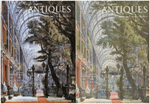
Figure x. Left: Transformation of Antiques Magazine Cover into the Bogeyman of Face, past Salvador Dali, Gouache on mag cover, 1974. ©Salvador Dali. Fundación Gala-Salvador Dali (Artist Rights Society), 2015. Collection of the Salvador Dali Museum, Inc., St. Petersburg, FL, 2015. Reproduced with kind permission from the Salvador Dali Museum, Inc. Correct: Antiques original 1974 cover for comparison.
But when we focus on the paradigm as a whole, especially when nosotros stride dorsum, the strongly contrasting edges of the dark tree against the light background provide us with sufficient cues to detect a confront. The shading and changes of tone within the backdrop also shape our perception of the curvature of the face and the protruding eyebrows, nose and lips. Even with the obvious confront, nonetheless, the scene of a tree in a mall is not lost, and our listen switches back and along betwixt face up and scene interpretations.
Illustration for "Tres Picos"—Watercolor and Ink Conversion of Impress, 1955
Dali wrote in 1942 the Total Camouflage of Full State of war, in which he states, "The discovery of 'invisible images' was certainly my destiny (Dali, 1998b)." His skill of employing a variety of techniques to create unusual effects in his art is based on his ability of "seeing things differently." Dali'southward capacity to "read" other configurations in illustrations by other artists prompted this interpretation of Tres Picos (Figure 11).
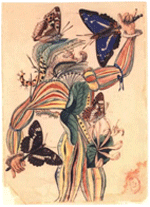
Figure xi. Illustration for "Tres Picos," by Salvador Dali, Watercolor and ink conversion of print, 1955. ©Salvador Dali. Fundación Gala-Salvador Dali (Artist Rights Club), 2015. Collection of the Salvador Dali Museum, Inc., St. Petersburg, FL, 2015. Reproduced with kind permission from the Salvador Dali Museum, Inc.
Dali's apply of the butterfly highlights his appreciation for the insect's natural beauty and his attraction to it as a symbol of metamorphosis. The ambivalence in this illusion comes from the costumed human being both a man, and a configuration of butterflies, larva, and plants. The male person and the female of the Apatura Iris (Purple Emperor) species of butterfly can be perceived every bit either butterflies, or every bit fans or masks for a formal masquerade. A caterpillar crimper into a leafage to pupate forms the man's tricorner hat, while a butterfly alighting on tiptop could also be a hat plume.
Dali and the surrealist movement rediscovered the amusing and reality-stretching artwork of the Italian painter Giuseppe Arcimboldo (1527–1593), which likely inspired pieces such every bit Tres Picos. Arcimboldo'due south portraits are ambiguous illusions because our perceptions dance between seeing a face and a collection of fruits and vegetables. Both are familiar objects to our brain and Arcimboldo controlled the variables of the painting to keep information technology intriguingly ambiguous.
The pear that defines the nose in Arcimboldo's Autumn (Figure 12) is not a bright yellowish or greenish equally pears tin be. Instead, the hue (color) is chosen to be yellow-orangish, with muted tones. Gradations in value, especially increasing at edges, suggest profile, mass, and dimension. It is a pear to our perception: but it is besides a plausible olfactory organ. Each fruit or vegetable is thus chosen to define the color and profile of its part of the portrait. They blend in such a mimicking fashion that our mind has to "await twice" to make sense of what it is seeing.
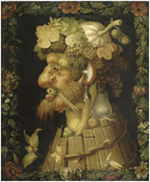
Figure 12. Autumn, by Arcimboldo.
The brain articles object representations from discrete features, like line fragments and minute color patches. We perceive a nose in Autumn, not due to a retinal neuron that processes noses, merely to a myriad photoreceptors that react to the various shades of luminance and color in that region of the painting. Cortical circuits afterwards friction match that information to our neural template for noses. The same photoreceptor output also allows other cortical neurons to discern the pears, grapes, and leaves, making images like these and then delightful to contemplate.
Every bit is oftentimes the instance with this type of cryptic illusion (see Gala Contemplating the Mediterranean…for a spectacular instance), stepping dorsum and squinting our eyes homogenizes the values, de-saturates the hues, and blurs the edges that our brain uses to define details in shapes, allowing united states to run into the face equally a whole, rather than as a collection of fruits and vegetables.
Whereas many of Arcimboldo's portraits are examples of mosaicism, where a big object such equally a chapeau is made up of smaller ones such as grapes and leaves, Dali's cryptic images usually involve reversals of effigy and background.
The Sheep—Gouache on a Chromolithography by Schenck, 1942
The Sheep demonstrates Dali's chapters to scrutinize and reconfigure the visual world, so present this new vision for others to see. Dali applies gouache to a reproduction of Albrecht Schenck's chromolithograph, Lost on the Mount (c. 1873/84) to add or absorb out details, blurring the line betwixt the original and his additions. Compare Schenck'due south original Lost on the Mountain (Effigy thirteen, right) to Dali's The Sheep (Figure 13, left).

Figure xiii. Left: The Sheep, by Salvador Dali, Gouache on a chromolithography by Schenck, 1942. Heart: Lamp detail. ©Salvador Dali. Fundación Gala-Salvador Dali (Artist Rights Society), 2015. Collection of the Salvador Dali Museum, Inc., St. Petersburg, FL, 2015. Reproduced with kind permission from the Salvador Dali Museum, Inc. Right: Lost on the Mountain, by Albrecht Schenck, c. 1873/84.
Equally nosotros wait at The Sheep, the scene surprises our mind with a number of ambiguous images. Nosotros recognize a familiar herd of sheep but they appear to be inside a room, and be part of the piece of furniture. Thus we perceive something that fluctuates between effects and a grouping of animals.
The face of the woman also features an ambiguous illusion. The face up is subtle, which could almost be texturing on the wall. Although the ii interpretations alternating in our perception, the context of the woman'south body in repose and the numerous facial details bias our facial recognition system toward perceiving a face.
Close examination of the lamp on the tabular array (Figure 13, middle) reveals an eye, ears, nose, rima oris and cervix, which together with the lamp's shade, provide our visual circuits with plenty of cues to fill in the information that is missing and thus friction match our neural template for a face.
La Lecon d'Anatomie (The Anatomy Lesson)—Ink on Paper, 1965
Dali reinterpreted Rembrandt's The Beefcake Lesson of Dr. Jan Deyman, 1656 (Figure 14). The original painting was based on the public dissection of an executed criminal at the Anatomy Theater of the Guild of Surgeons in Amsterdam. Wealthy citizens and physicians observed the procedure (Figure 14, right).

Figure fourteen. Left: La Lecon d'Anatomie (The Beefcake Lesson), past Salvador Dali, Ink on paper, 1965. Middle: Inkblots detail. ©Salvador Dali. Fundación Gala-Salvador Dali (Artist Rights Society), 2015. Collection of the Salvador Dali Museum, Inc., St. Petersburg, FL, 2015. Reproduced with kind permission from the Salvador Dali Museum, Inc. Right: The Anatomy Lesson of Dr. January Deyman, by Rembrandt, 1656.
Dali's ink limerick utilizes elements similar to the original with 7 inkblots bearing subtle figures of Diego Velazquez (1599–1660), Christ, and Dali himself (Figure fourteen, left). The cadaver is angled with Velazquez to the right, using a saw to open up the attic exposing the brain of the subject. The confront of Christ is to the left with his eyes closed.
In keeping the inked images of faces subtle, Dali advisedly crafted an cryptic illusion where our mind juggles dorsum and forth between seeing faces inside the blots (Figure 14, center), or seeing the dark inkblots themselves contrasting sharply against the white newspaper as a set, perhaps suggesting blood spatter from the body laying at the bottom of the scene.
Decalcomania—Watercolor on Blackness Paper, 1936
The neural bases of imagination are poorly understood. Dali's imagination, perhaps more fertile than almost, was driven by his paranoic-critical methodology of seeing things in surprising ways. Dali, and other surrealist artists of the time, experimented with Oscar Dominguez'southward (1906–1957) decalcomania technique of folding a piece of paper with wet gouache and peeling it back slowly to reveal a design for the artist to discover a spontaneous reality within.
Our brain is wired to observe meaning and structure around the states, then nosotros struggle to make sense of images similar Dali's Decalcomania (Effigy 15). Border and contour detection starts with our retinal neurons, which then laissez passer on that data to later stages of visual processing in the encephalon, until it reaches the cortical areas responsible for our perception of shape and color. Along the way, we compare the incoming visual information to known objects in our memories. If information technology makes sense, similar perhaps the haunting skeletal shape of a female with red hair around a face, we accept information technology. If it does not, we may conjure up alternative interpretations.
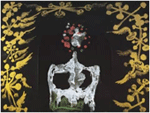
Figure 15. Decalcomania, past Salvador Dali, Watercolor on blackness newspaper, 1936. ©Salvador Dali. Fundación Gala-Salvador Dali (Artist Rights Society), 2015. Collection of the Salvador Dali Museum, Inc., St. Petersburg, FL, 2015. Reproduced with kind permission from the Salvador Dali Museum, Inc.
The high dissimilarity forms bring Rorschach inkblot tests to heed, and similarly prompt our imagination to identify specific shapes. The symmetry helps the perceptual clan to similar objects, as many things in the natural world are symmetrical. Although this is a type of ambiguous illusion, here Dali has not embedded two competing images that confuse the brain. The ambiguity lies in the lack of genuine images, so the encephalon is challenged to conjure any number of rivalrous hypotheses. This is also a filling-in illusion: our visual neurons fill in and complete the positive and negative spaces to help u.s.a. resolve familiar objects.
Head of Donkey—Ink, 1936
Dali explored the decalcomania process of gouache on folded paper (in this case, stationary from the business firm of Edward James, Dali's patron), to then open it and let his paranoic-critical imagination look for images within. Rorschach ink-blot in nature, images like these provoke our imagination to look for familiar shapes or meaningful images inside them. In this particular example, the image looked insect-like when viewed one manner, only became the Caput of a Donkey when turned upside-down (Figure 16).

Effigy xvi. Left: Head of Donkey, by Salvador Dali, Ink, 1936. Right: Rotated to see the insect. ©Salvador Dali, Fundación Gala-Salvador Dali (Artist Rights Club), 2015. Collection of the Salvador Dali Museum, Inc., St. Petersburg, FL, 2015. Reproduced with kind permission from the Salvador Dali Museum, Inc.
Our brain is wired to notice, identify and discriminate facial expressions and features from minimum data. This capacity is essential to our social interactions and the reason we attribute emotions and personality to objects such as rudimentary masks and the front end ends of vehicles. In that case, why don't nosotros perceive the ass's face when we rotate the prototype vertically? The reason is that the neural processes that allow us to run into faces rapidly and effortlessly are optimized to detect right-side-up faces, so upside-down faces are harder to distinguish (Figure 17).
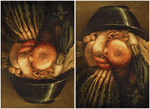
Figure 17. This even so life by Arcimboldo depicts a bowl of vegetables (left) that becomes a fanciful portrayal of a human's head, capped with a bowler hat, when turned upside down (right).
Gala Contemplating the Mediterranean Sea Which at Twenty Meters Becomes the Face up of Abraham Lincoln—Homage to Rothko—2nd Version, Oil on Canvas, 1976
Some other manner to create ambiguous illusions is by pitting high-resolution fine item against low-resolution overriding shapes, as in Dali's Gala Contemplating the Mediterranean Sea, which at Twenty Meters Becomes the Portrait of Abraham Lincoln, i of the painter's finest ambiguous illusions (Figure 18).

Effigy 18. Left: Gala Contemplating the Mediterranean Bounding main Which at 20 M Becomes the Face of Abraham Lincoln—Homage to Rothko, by Salvador Dali. 2nd version, oil on canvas, 1976. ©Salvador Dali. Fundación Gala-Salvador Dali (Creative person Rights Guild), 2015. Collection of the Salvador Dali Museum, Inc., St. Petersburg, FL, 2015. Reproduced with kind permission from the Salvador Dali Museum, Inc. Right: Harmon's original 16 × 16 greyness-scale cake averaging image of Lincoln. Dali pays tribute to Harmon by including this image equally ane of the cells in the lower left of his painting.
Dali created this piece after reading about Leon D. Harmon's groundbreaking work, published in 1973 in Scientific American with the title "The Recognition of Faces." Harmon had produced "block averaging" renderings of a moving picture of Abraham Lincoln, taken from a $5 beak. Block averaging entails breaking downwards an paradigm into blocks of a grid, and filling each block with its average grayness-scale value; in other words, assigning a single tone to each pixel. Harmon establish that 16 × 16 (256 total) was the smallest number of blocks necessary to recognize a face (Harmon, 1973).
The homage to Mark Rothko (1903–1970) paid tribute to the abstract expressionist, who had recently committed suicide. Dali used blocks of color in hues that bring to mind Rothko's "colour field" paintings.
Gala's effigy is comprised of high spatial frequencies, whereas Lincoln'south confront contains low spatial frequencies. When nosotros stand close we focus on the smashing differences of value and hue, and the other loftier-spatial frequency particulars, so nosotros discover a crucifixion rendered in heavy impasto in the heaven, and Gala staring out a cruciform window facing the sea. Such loftier spatial frequencies, which govern our perception at close range, obscure Lincoln'south face.
Equally nosotros stand farther away (20 m) from the painting, the depression spatial frequencies dominate our perception instead: nosotros now see the coarser, less intricate elements of the scene, rather subtle details such as Gala'due south outline and the edges of the large blocks. Nosotros no longer witness Gala; the high spatial frequencies that define her trunk blend into the surrounding region (which has like low-cal values to those in Gala's effigy), leaving u.s. just with the full general low spatial frequency shadings and shapes that constitute Lincoln'southward face. Squinting our eyes near the painting also helps us smear and soften the edges, by removing the high spatial frequency information and revealing the face "hidden" in the low frequencies. Dali's choice of hues, values, tones, textures, and saturation for the sea, clouds, and Gala's body thus become appropriate shading to perceive Lincoln's skin.
Once we get-go to recognize Lincoln's visage, our face-processing neurons contribute additional details to fill in the image. After we connect Lincoln's face to a specific group of squares, it is hard to end seeing it. Dali and Harmon did not pick Lincoln at random: nosotros identify familiar faces more easily than unfamiliar ones.
Re-approaching the painting makes Lincoln disappear and Gala reappear, as the painting becomes once over again subjugated to fine details.
Many of Dali'due south artworks involving double images rely on the coaction of high and low spatial frequencies, so when we step back or squint our eyes the low frequencies dominate (typically revealing a large portrait), but when we move in shut the high frequencies take over instead (usually depicting a detailed scene). (See for example Nieuw Amsterdam, The Three Ages, Changes in Neat Masterpieces, Rembrandt, or Transformation of Antiques Magazine Embrace).
An interactive installation named "Gala Contemplating You" was the centerpiece of the "Marvels of Illusion" showroom at the Dali Museum. "Gala Contemplating You" replaced Lincoln'southward image in the Gala Contemplating … painting with the blocked portraits of museum visitors (See http://www.galacontemplatingyou.com/gallery/1).
Depth Perception and Stereoscopic Vision in Dali's Art
On a flat canvas, in that location is no bodily foreground or background: a flat picture involving perspective is a type of illusion. Since the visual system but has indirect admission to depth information well-nigh its environment (our retinas are essentially bi-dimensional), we feel the tertiary dimension ever every bit a mental construct, both when nosotros look at art in the museum and out in the earth. Depth perception is the consequence of a gear up of rules, originated in neural calculations, which artists utilize to create compelling three-dimensional illusions in their work. These rules comprise vanishing points, size, occlusion, shading and gradation, chiaroscuro, sfumato, and the level of transparency of the atmosphere. The same rules, likewise chosen monocular cues of depth perception, drive our real earth perception–which is the reason that they besides apply to artworks such as Dali's breathtaking paintings.
In the real world, our visual system moreover relies on binocular, or stereoscopic cues to depth perception.
Crucifixion (Christ of Gala)—Lithograph, 1981
Stereopsis is the neural mechanism by which the visual arrangement combines the horizontally displaced images from the left and right eye to produce a 3D percept. Dali'due south interest in perception led him to experiment with stereoscopic vision, creating a number of paintings every bit stereo-pairs. That is, he achieved iii-dimensionality past creating two versions of the same scene (one for each eye of the observer, thus mimicking the horizontal disparity of binocular images in natural vision). Each painting was meticulously rendered from slightly dissimilar viewing points, equivalent to the differences that would result from viewing the aforementioned prototype with the right vs. the left eye, had the observer witnessed this scene in real life. Dali'south adjustments to position, tone, lighting and symmetry took into business relationship the altitude between the viewer and the image.
Crucifixion combines very finer binocular cues (stereopsis) and monocular cues to depth perception, the latter most powerfully in the form of vanishing points (i.east., the cantankerous appears to recede in the distance, even when nosotros close 1 eye). When we observe both images side-by-side, with the left eye focused on the left moving-picture show, and the right eye on the right film, our visual system combines both images into a unmarried 3-dimensional one (Figure 19).

Figure 19. Crucifixion (Christ of Gala), by Salvador Dali, Lithograph, 1981. ©Salvador Dali. Fundación Gala-Salvador Dali (Artist Rights Society), 2015. Drove of the Salvador Dali Museum, Inc., St. Petersburg, FL, 2015. Reproduced with kind permission from the Salvador Dali Museum, Inc.
Le Crane (Skull)—Lithograph, 1972
Dali's 1972 image Le Crane (Skull), from his 1972 lithograph suite Anamorphoses, combines an optical illusion (the reflection of the image provided by the cylindrical mirror) with a visual illusion involving anamorphic perspective. Anamorphic images are distorted so that they are unevenly enlarged along perpendicular axes. These images are not immediately recognizable from all sides, only appear normal when viewed from a particular signal, shallow angle, or with a particular lens or mirror. In Le Crane, what appears at starting time glance to be an abstract swirl is recognized in the mirror every bit a skull. Skulls are oft used by artists as a reminder of human temporality. By hiding the skull within an abstract blueprint, Dali appears to hibernate a undercover about human nature that the viewer tin can unlock but by using the necessary device, the cylindrical mirror (Figure xx).

Figure 20. Le Crane (Skull). From Anamorphoses, by Salvador Dali, Lithograph, 1972. ©Salvador Dali. Fundación Gala-Salvador Dali (Artist Rights Society), 2015. Collection of the Salvador Dali Museum, Inc., Saint petersburg, FL, 2015. Reproduced with kind permission from the Salvador Dali Museum, Inc.
Dix Recettes d'Immortalite (X Recipes of Immortality)—Engraving, 1973
Whereas in Crucifixion the viewer must uncross his or her eyes to achieve stereovision, in Immortal Monarchy from the "Ten Recipes of Immortality" suite, the viewer places his or her nose at the apex of v-angled mirrors, to force each eye to see only a specific prototype. The visual cortex then combines the two images to perceive a three-dimensional sphere (Figure 21, right).

Effigy 21. Ii examples from Dix Recettes d'Immortalite (10 Recipes of Immortality), by Salvador Dali, Engraving, 1973. Left and center: Anamorphosis. Right: Immortal Monarchy. ©Salvador Dali. Fundación Gala-Salvador Dali (Creative person Rights Society), 2015. Collection of the Salvador Dali Museum, Inc., St. Petersburg, FL, 2015. Reproduced with kind permission from the Salvador Dali Museum, Inc.
In the Anamorphosis box structure, as well from the "X Recipes of Immortality" suite, the viewer's perception changes radically just by irresolute his or her visual signal of view, revealing additional images including both an anamorphic skull by Dali, and a 2nd anamorphic skull by Hans Holbein the Younger, from the 1533 painting Les Ambassadors (Figure 21, left and center). Through such illusions, artists from the Renaissance on have suggested a class of imagery that tin only exist understood by those who know its secrets.
Conclusions
We have described how Dali fabricated constant use of illusions in his artworks to mistiness the distinction between fact and fantasy, a hallmark of the surrealist motion. Illusions are—or should be—a cardinal part of the neuroscientist'southward toolbox to explore how the encephalon creates an internal representation of the external world. In add-on, illusions add an intellectual dimension to the aesthetic and emotional engagement that typically characterizes the experience of art. Dali's utilize of illusion forces the viewer to interact with his artworks in a questioning, analytical way, so as to puzzle out what is perception vs. reality. He transforms the observer into an active practitioner of Dali'southward signature paranoic-critical method, by which any object can be seen as another.
Conflict of Interest Argument
The authors declare that the enquiry was conducted in the absence of whatever commercial or fiscal relationships that could be construed as a potential conflict of involvement.
Acknowledgments
This work was supported by a challenge grant from Enquiry to Preclude Blindness Inc. to the Department of Ophthalmology at SUNY Downstate, by the Empire Innovation Plan (Awards to SMC and SLM), and past the National Science Foundation (Honor 1523614 to SLM). Worldwide rights @ Salvador Dali. Fundació Gala-Salvador Dali (Creative person Rights Guild) 2015. Works from the Dali Museum Collection: in the USA @ Salvador Dali Museum, Inc., St. Petersburg Museum, Florida, 2012. Nosotros thank Max Dorfman for administrative and writing assist.
References
Dali, South. (1935). Salvador Dali: The Conquest of the Irrational. New York, NY: Julien Levy.
Dali, South. (1998a). "The rotting donkey," in The Collected Writings of Salvador Dali, Edited and Transl. by H. N. Finkelstein (Cambridge: Cambridge University Press), 224.
Dali, Due south. (1998b). "Total cover-up of total war," in The Collected Writings of Salvador Dali, Edited and Transl. by H. N. Finkelstein (Cambridge: Cambridge University Press), 340.
Da Vinci, L. (1956). A Treatise on Painting, Vol. 2. Princeton, NJ: Princeton University Press.
Google Scholar
Martinez-Conde, S., and Macknik, S. 50. (2010). The neuroscience of illusion. Sci. Am. Spec. Rep. twenty, four–7. doi: 10.1038/scientificamericanmind0510-4sp
CrossRef Full Text | Google Scholar
Martinez-Conde, Southward., and Macknik, Due south. L. (2012). A faithful resemblance. Sci. Am. Mind 23, sixteen–xviii. doi: 10.1038/scientificamericanmind0712-xvi
CrossRef Full Text | Google Scholar
0 Response to "Salvador Dali Museum Florida Art Contest in the 90s"
Post a Comment